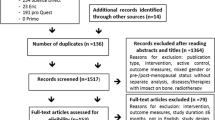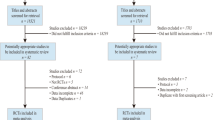Abstract
Summary
Inconsistent study findings of exercise on areal bone density highlight the need to include parameters of bone geometry and volumetric bone density measurements. Using a systematic review and meta-analysis, we found a decrease in bone loss through the maintenance of cortical and trabecular volumetric bone mineral density (BMD). Studies with longer exercise durations and larger sample sizes are needed.
Introduction
Exercise has long been recommended to prevent age-related loss of bone mass in postmenopausal women. However, inconsistent study findings on the effect of exercise on BMD preservation have highlighted the importance of extending the evaluation of bone to include the parameters of bone geometry. We conducted both a systematic review and meta-analysis of the effects of exercise on bone geometry and volumetric BMD in postmenopausal women.
Methods
We searched MEDLINE, PubMed, and EMBASE from 1950 to April 2009 and included prospective, randomized controlled trials of healthy postmenopausal women where the intervention involved exercise or sport and outcomes included quantitative or peripheral quantitative computed tomography bone parameters. Outcome variables included: total volumetric BMD, cortical volumetric BMD (CvBMD), trabecular volumetric BMD (TrvBMD), total bone mineral content, cortical BMC, total bone area, cortical area, polar stress–strain index, and bone strength index.
Results
Six studies satisfied our inclusion and exclusion criteria. Lower extremity exercises resulted in small (∼0.9%) but significant improvements in TrvBMD of the distal tibia (p = 0.0006) and in CvBMD of the tibial shaft (p = 0.0007). Studies with longer durations of exercise (12 months) and those in early postmenopausal women showed significant changes in CvBMD at the tibial shaft.
Conclusions
We conclude that exercise in postmenopausal women may decrease bone loss by maintaining cortical and trabecular volumetric BMD. To better understand the effect of exercise on bone geometric structure and strength, more studies of longer duration and larger sample sizes are needed.





Similar content being viewed by others
References
Asikainen TM, Kukkonen-Harjula K, Miilunpalo S (2004) Exercise for health for early postmenopausal women: a systematic review of randomised controlled trials. Sports Med 34:753–778
Bérard A, Bravo G, Gauthier P (1997) Meta-analysis of the effectiveness of physical activity for the prevention of bone loss in postmenopausal women. Osteoporos Int 7:331–337
Martyn-St JM, Carroll S (2008) Meta-analysis of walking for preservation of bone mineral denisty in postmenopausal women. Bone 43:521–531
Chan K, Qin L, Lau M, Woo J, Au S, Choy W, Lee K, Lee S (2004) A randomized, prospective study of the effects of Tai Chi Chun exercise on bone mineral density in postmenopausal women. Arch Phys Med Rehabil 85:171–722
Kemmler W, Engelke K, Weineck J, Hensen J, Kalender WA (2003) The Erlangen fitness osteoporosis prevention study: a controlled exercise trial in early postmenopausal women with low bone density-first-year results. Arch Phys Med Rehabil 84:673–682
Snow CM, Shaw JM, Winters KM, Witzke KA (2000) Long-term exercise using weighted vests prevents hip bone loss in postmenopausal women. J Gerontol 55A:M489–M491
Stengel SV, Kemmler W, Pintag R, Beeskow C, Weineck J, Lauber D, Kalender WA, Engelke K (2005) Power training is more effective than strength training for maintaining bone mineral density in postmenopausal women. J Appl Physiol 99:181–188
Kerr D, Ackland T, Maslen B, Moron A, Prince R (2001) Resistance training over 2 years increases bone mass in calcium-replete postmenopausal women. J Bone Miner Res 16:175–181
Kelley GA, Kelley KS, Tran ZV (2002) Exercise and lumbar spine bone mineral density in postmenopausal women: a meta-analysis of individual patient data. J Gerontol 57:M599–M604
Wolff I, Van Croonenborg J, Kemper HCG, Kostense PJ, Twisk JWR (1999) The effect of exercise training programs on bone mass: a meta-analysis of published controlled trials in pre- and postmenopausal women. Osteoporos Int 9:1–12
Dougherty G (1996) Quantitative CT in the measurement of bone quantity and bone quality for assessing osteoporosis. Med Eng Phys 18:557–568
Bouxsein ML, Karaski D (2006) Bone geometry and skeletal fragility. Curr Osteoporos Rep 4:49–56
Dalle Carbonare L, Valenti MT, Bertoldo F, Zanatta M, Zenari S, Realdi G, Lo Cascio V, Giannini S (2005) Bone microarchitecture evaluated by histomorphometry. Bone Struc Health Dis 36:609–616
Pang MYC, Ashe MC, Eng JJ, McKay HA, Dawson AS (2006) A 19-week exercise program for people with chronic stroke enhances bone geometry at the tibia: a peripheral quantitative computed tomography study. Osteoporos Int 17:1615–1625
Uusi-Rasi K, Kannus P, Cheng S et al (2003) Effect of alendronate and exercise on bone and physical performance of postmenopausal women: a randomized controlled trial. Bone 33:132–143
Cheng S, Sipila S, Taafe DR, Puolakka J, Suominen H (2002) Change in bone mass distribution induced by hormone replacement therapy and high-impact physical exercise in post-menopausal women. Bone 31:126–135
Karinkanta S, Heinonen A, Sievanen H, Uusi-Rasi K, Pasanen M, Ojala K, Fogelholm M, Kannus P (2006) A multi-component exercise regimen to prevent functional decline and bone fragility in home-dwelling elderly women: randomized, controlled trial. Osteoporos Int 18:453–462
Liu-Ambrose TY, Khan KM, Eng JJ, Heinonen A, McKay HA (2004) Both resistance and agility training increase cortical bone density in 75- to 85-year-old women with low bone mass. J Clin Densitom 7:390–398
Jadad AR, Moore RA, Carroll D, Jenkinson C, Reynolds DJM, Gavaghan DJ, McQuay HJ (1996) Assessing the quality of reports of randomized clinical trials: is blinding necessary? Control Clin Trials 17:1–12
Brouwers MC, Johnston ME, Charette ML, Hanna SE, Jadad AR, Browman GP (2005) Evaluating the role of quality assessment of primary studies in systematic reviews of cancer practice guidelines. BMC Med Res Methodol 5:8
DeAngelis CD (2008) Instructions for authors. JAMA 299:821
Moher D, Cook DJ, Eastwood S, Olkin I, Rennie D, Stroup DF, Group ftQ (2008) Improving the quality of reports of meta-analyses of randomised controlled trials: the QUOROM statement. Lancet 354:1896–1900
Higgins JP, Thompson SG, Deeks JJ, Altman DG (2003) Measuring inconsistency in meta-analyses. BMJ 327:557–560
Hamilton CJ, Swan VJ, Jamal SA (2010) The effects of exercise and physical activity participation on bone mass and geometry in postmenopausal women: a systematic review of pQCT studies. Osteoporos Int 21:11–23
Nikander R, Sievänen H, Heinonen A, Daly RM, Uusi-Rasi K, Kannus P (2010) Targeted exercise against osteoporosis: a systematic review and meta-analysis for optimising bone strength throughout life. BMC Med 8:47
Adami S, Gatti D, Braga V, Bianchini D, Rossini M (1999) Site-specific effects of strength training on bone structure and geometry of ultradistal radius in postmenopausal women. J Bone Miner Res 14:120–124
Bischoff-Ferrari HA, Willett WC, Wong JB, Giovannucci E, Dietrich T, Dawson-Hughes B (2005) Fracture prevention with vitamin D supplementation: a meta-analysis of randomized controlled trials. JAMA 293:2257–2264
Bunout D, Barrera G, Leiva L, Gattas V, Pia de la Maza M, Avendano M, Hirsch S (2006) Effects of vitamin D supplementation and exercise training on physical performance in Chilean vitamin D deficient elderly subjects. Exper Gerontol 41:746–752
Cranney A, Horsley T, O’Donnell S, et al. (2007) Effectiveness and safety of vitamin D in relation to bone health. Evid Rep Technol Assess 1–235
Mezquita-Raya P, Munoz-Torres M, De Dios LJ, Luna V, Lopez-Rodriguez F, Torres-Vela E, Escobar-Jimenez F (2001) Relation between vitamin D insufficiency, bone density, and bone metabolism in healthy postmenopausal women. J Bone Miner Res 16:1408–1415
Trivedi DP, Doll R, Khaw KT (2003) Effect of four monthly oral vitamin D3 (cholecalciferol) supplementation on fractures and mortality in men and women living in the community: randomised double blind controlled trial. BMJ 326(7387):469
Moher D, Jadad AR, Tugwell P (1996) Assessing the quality of randomized controlled trials. Int J Tech Assess Health Care 12:195–208
Moher D, Pham B, Jones A, Cook DJ, Jadad AR (1998) Does quality of reports of randomised trials affect estimates of intervention efficacy reported in meta-analyses? Lancet 352:609–613
Schulz KF, Chalmers I, Hayes RJ, Altman DG (1995) Empirical evidence effects in controlled trials of bias: dimensions of methodological quality associated with estimates of treatment. JAMA 273:408–412
Irwin ML, Tworoger SS, Yasui Y et al (2004) Influence of demographic, physiologic, and psychosocial variables on adherence to a yearlong moderate-intensity exercise trial in postmenopausal women. Prev Med 39:1080–1086
Resnick B, Magaziner J, Orwig D, Zimmerman S (2002) Evaluating the components of the exercise plus program: rationale, theory and implementation. Health Educ Res 17:648–658
Ryan RM, Deci EL (2007) Active human nature: self-determination theory and the promotion and maintenance of sport, exercise, and health. In: Hagger MS (ed) Intrinsic motivation and self-determination in exercise and sport. Human Kinetics Europe Ltd., Pudsey, pp 1–19
Riggs BL, Melton LJ (1995) The worldwide problem of osteoporosis: insights afforded by epidemiology. Bone 17:S505–S511
Seeman E (2002) An exercise in geometry. J Bone Miner Res 17(3):373–380
Dalsky GP, Stocke KS, Ehsani AA, Slatopolsky E, Lee WC, Birge SJJ (1988) Weight-bearing exercise training and lumbar bone mineral content in postmenopausal women. Ann Intern Med 108:824–828
Jiang Y, Zhao J, Rosen C, Geusens P, Genant HK (1999) Perspectives on bone mechanical properties and adaptive response to mechanical challenge. J Clin Densitom 2:423–433
Acknowledgments
We wish to sincerely thank the librarians of The Scarborough Hospital, General Division, Scarborough, Ontario, Canada, Deborah Lambert, and Judy Ng and the librarian of the Department of Family & Community Medicine, University of Toronto, Toronto, Canada, Rita Shaughnessy for their assistance with the literature searches, as well as Zoe Agnidis for her assistance in the preparation of this manuscript. We also wish to thank Debra Butt and Conor McDermott for their guidance, inspiration, and support in the production of this paper. Dr. A.M. Cheung is funded by the Canadian Institutes of Health Research/Institute of Gender and Health Senior Scientist Award and the University of Toronto/University Health Network Lillian Love Chair in Women’s Health.
Conflicts of interest
None.
Author information
Authors and Affiliations
Corresponding author
Rights and permissions
About this article
Cite this article
Polidoulis, I., Beyene, J. & Cheung, A.M. The effect of exercise on pQCT parameters of bone structure and strength in postmenopausal women—a systematic review and meta-analysis of randomized controlled trials. Osteoporos Int 23, 39–51 (2012). https://doi.org/10.1007/s00198-011-1734-7
Received:
Accepted:
Published:
Issue Date:
DOI: https://doi.org/10.1007/s00198-011-1734-7




